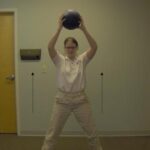Hip flexor training must not be ignored. Read this article to learn how to strengthen hip flexors.
I’m a certified personal trainer and I make sure that the hip flexor group of muscles get included in my clients’ workout sessions. This muscle group (responsible for enabling you to bend your thigh up so that there is a 90-degree angle between your thigh and hip, like a marching step – thigh parallel to floor; this can also be done with a sideways thigh, knee pointing toward someone standing to your side) is often ignored by personal trainers, and certainly, by average fitness enthusiasts, because the quadriceps (thigh), hamstrings (back of thigh) and calves usually get all the attention. But if you neglect your hip flexors, then eventually, the following might happen:
Difficulty or quick fatigue upon “lifting your legs up” when walking on surfaces that demand this, such as through snow, over debris, etc. Difficulty climbing up on platforms. Difficulty or fatigue climbing stairs. Difficulty getting out of deep chairs. Difficulty getting out of cars, and also:
Though most of the preceding problems aren’t an imminent concern for younger people, young people with de-conditioned hip flexors will indeed have problems with core routines that involve bringing the torso towards the thighs, such as when sitting on a declined bench, feet tucked beneath the pads, and doing sit-ups. Another routine that quickly fatigues de-conditioned hip flexors, before the abs or lower back tire out, is any routine involving a standard crunching machine. Straight leg raises, while lying on the floor, will also be impeded by weak hip flexors.
As typical people age, they all experience these problems. Even younger people can tire easily performing some of these motions, if they don’t do hip-flexor-specific routines.
Hip flexor strengthening drills
1. Step back and forth over a bar. You can use the Smith machine bar. For more height variation, use the safety bars on the sides of the Smith machine. Do front and side step-overs.
2. Stepping drills on a high step-class platform will also work. Include “straddle steps.” The stepping need not be fast. This is not an aerobics drill. It is a stepping drill. Thus, if you must step carefully and slowly to clear the height, then do so. Also step backwards, but use a lower height.
3. Sit on a bench, stool or elevated step-class platform. Have someone stand behind you to catch you in case you begin toppling backwards onto the floor. Lift both feet simultaneously off the floor, getting the knees high, and then back down, only the balls of feet touching down with each rep – without hands holding onto anything. If you hold onto the seat or her legs, this defeats the entire purpose. Your partner should not support you because he is standing behind you only to catch you in case you lose control. Try to get the knees up high with each lift, for 20 reps. If this is not possible, use a lower seat.
4. Stand in one place, and march with high knees, 20-30 reps per leg, two sets. One set has the knees facing forward (front hip flexion), and the second set has them facing towards the sides (lateral hip flexion). Caution: Marching in lateral hip flexion can pull a muscle in poorly conditioned individuals. Use your discretion. If you are poorly conditioned, stiff or older, start out with maybe only eight reps per leg, and march with low knees to start, rather than high. For well-conditioned people, place hands out, palms down, and touch knees to palms.
5. If your gym offers kickboxing classes, participate in these. They involve lots of hip flexor motions.
6. This next routine is not for beginners. Sit on bench or high stepper platform. Again, have a partner stand behind you, but make sure partner does not touch you unless you are beginning to topple backwards. This routine is the same as No. 3, except that you bring heels up to edge of the bench for each rep, and actually tap heels onto bench or platform (no resting there, just a very brief tap), before placing balls of feet back on the floor. Do not hold onto anything. Go for 20-30 reps. Make sure seat height is challenging.



